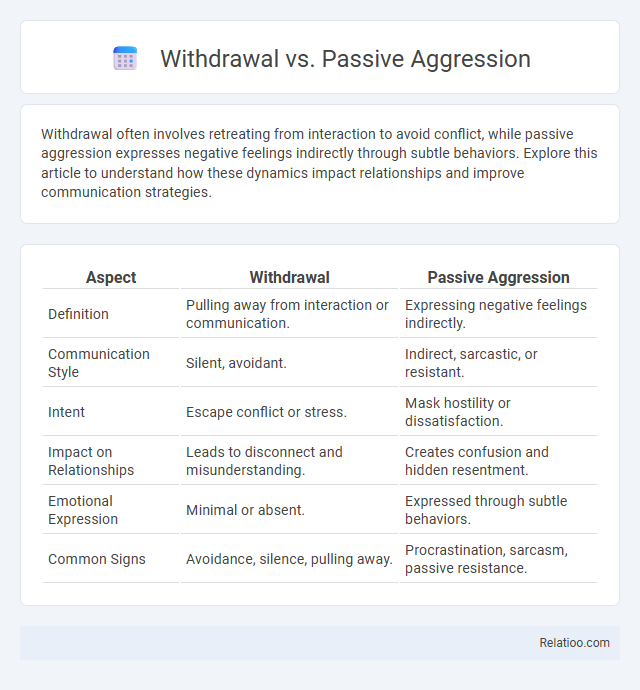Withdrawal often involves retreating from interaction to avoid conflict, while passive aggression expresses negative feelings indirectly through subtle behaviors. Explore this article to understand how these dynamics impact relationships and improve communication strategies.
Table of Comparison
| Aspect | Withdrawal | Passive Aggression |
|---|---|---|
| Definition | Pulling away from interaction or communication. | Expressing negative feelings indirectly. |
| Communication Style | Silent, avoidant. | Indirect, sarcastic, or resistant. |
| Intent | Escape conflict or stress. | Mask hostility or dissatisfaction. |
| Impact on Relationships | Leads to disconnect and misunderstanding. | Creates confusion and hidden resentment. |
| Emotional Expression | Minimal or absent. | Expressed through subtle behaviors. |
| Common Signs | Avoidance, silence, pulling away. | Procrastination, sarcasm, passive resistance. |
Understanding Withdrawal and Passive Aggression
Withdrawal involves retreating from social interaction or emotional engagement as a coping mechanism, often signaling avoidance or overwhelm. Passive aggression manifests through indirect resistance, such as procrastination, sarcasm, or subtle sabotage, reflecting unexpressed anger or frustration. Understanding these behaviors requires recognizing withdrawal as emotional self-protection, while passive aggression serves as masked hostility, both impacting communication and relationships differently.
Defining Withdrawal in Relationships
Withdrawal in relationships refers to the intentional or unintentional retreat from emotional or physical engagement with a partner, often as a coping mechanism to avoid conflict or distress. It differs from passive aggression, which involves indirect expressions of hostility such as sarcasm or subtle sabotage, whereas withdrawal is characterized by silence, avoidance, or detachment. Understanding withdrawal is crucial for recognizing patterns that can undermine intimacy and communication in partnerships.
What is Passive Aggression?
Passive aggression is a behavior characterized by indirect resistance to demands or expectations, manifesting through procrastination, sullenness, or stubbornness rather than overt confrontation. Unlike withdrawal, which involves pulling away or disengaging from interactions, passive aggression maintains a presence while expressing hostility covertly. Understanding passive aggression helps you recognize subtle communication patterns that can undermine relationships and productivity.
Core Differences Between Withdrawal and Passive Aggression
Withdrawal involves a person retreating physically or emotionally from a situation to avoid confrontation or stress, often leading to silence or disengagement. Passive aggression, by contrast, is characterized by indirect resistance and subtle behaviors such as procrastination, sarcasm, or intentional inefficiency to express hostility without open communication. The core difference lies in withdrawal being an avoidance strategy, whereas passive aggression actively conveys discontent through covert actions.
Psychological Motivations Behind Each Behavior
Withdrawal reflects a desire to avoid conflict or emotional overwhelm, driven by the need for self-protection and emotional regulation. Passive aggression stems from unexpressed anger or frustration, manifesting as indirect resistance or subtle sabotage to communicate dissatisfaction without overt confrontation. Avoidance, closely related to withdrawal, is motivated by fear of negative outcomes or discomfort, leading individuals to evade situations perceived as threatening or stressful.
Signs and Symptoms to Recognize
Withdrawal is characterized by social isolation, lack of communication, and avoidance of interactions, often indicating emotional distress or depression. Passive aggression manifests through indirect resistance, sarcasm, procrastination, and subtle hostility, signaling unexpressed anger or frustration. Recognizing these signs involves observing patterns of disengagement or covert negativity that impact relationships and emotional well-being.
Impact on Personal and Professional Relationships
Withdrawal often leads to emotional distance and communication breakdowns in personal and professional relationships, undermining trust and collaboration. Passive aggression manifests as indirect resistance and hidden hostility, causing confusion, resentment, and a toxic environment that hinders conflict resolution. Both behaviors negatively impact relationship dynamics by obstructing open dialogue and fostering misunderstandings, ultimately reducing overall relational satisfaction and productivity.
Common Triggers for Withdrawal vs Passive Aggression
Common triggers for withdrawal often include overwhelming stress, feelings of rejection, or fear of confrontation, leading individuals to isolate themselves emotionally or physically. In contrast, passive aggression is frequently triggered by unresolved resentment, perceived unfairness, or a desire to express anger indirectly, resulting in subtle sabotage or resistance. Both behaviors serve as coping mechanisms but differ in expression--withdrawal emphasizes avoidance, while passive aggression masks hostility beneath a facade of compliance.
Healthy Alternatives to Withdrawal and Passive Aggression
Withdrawal and passive aggression often mask underlying emotions, hindering open communication and conflict resolution. Healthy alternatives include expressing feelings assertively, setting boundaries, and seeking supportive dialogue to promote emotional transparency. Your ability to address issues directly fosters trust and improves relationship dynamics.
Strategies for Effective Communication and Conflict Resolution
Effective communication and conflict resolution require recognizing the differences between withdrawal and passive aggression behaviors. Withdrawal involves disengaging from the conflict, which can halt dialogue but create emotional distance, while passive aggression expresses dissatisfaction indirectly, often through sarcasm or procrastination. Your strategy should include encouraging open dialogue, using "I" statements to express feelings clearly, and fostering a safe environment where concerns are addressed promptly to prevent misunderstandings and build trust.

Infographic: Withdrawal vs Passive Aggression
 relatioo.com
relatioo.com